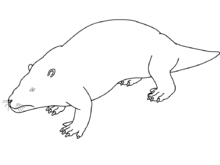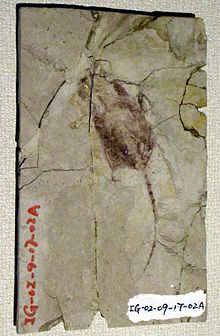Eutriconodonta
| Eutriconodonta | ||||||||||||
|---|---|---|---|---|---|---|---|---|---|---|---|---|
|
Gobiconodon , life reconstruction |
||||||||||||
| Temporal occurrence | ||||||||||||
| Middle Jurassic to Upper Cretaceous | ||||||||||||
| 70 to 165 million years | ||||||||||||
| Locations | ||||||||||||
|
||||||||||||
| Systematics | ||||||||||||
|
||||||||||||
| Scientific name | ||||||||||||
| Eutriconodonta | ||||||||||||
| Kermack , Musset & Rigney , 1973 | ||||||||||||
The Eutriconodonta (or Triconodonta ) are a possible taxon (a systematic group) of extinct mammals from the Mesozoic Era . They lived from the Middle Jurassic to the Upper Cretaceous and are characterized by common features in the structure of the molars (back teeth). Whether they actually form a natural group or just represent convergent developments is controversial.
features
Like numerous other mammalian groups of the Mesozoic Era, the Eutriconodonta are often only known through individual teeth or jaw parts, which makes a systematic classification difficult. A common feature of all of these animals is the structure of the molar teeth. These always had three large bumps arranged one behind the other, which made it possible to cut up the food. In some Eutriconodonta (such as the Triconodontidae ) the three humps were almost the same size, in other animals there was a significant increase in the middle hump. Some representatives had additional small cusps at the front and rear ends of the molars, which caused the neighboring teeth to mesh and thus provided additional stability when biting. The structure of the teeth indicates that many Eutriconodonta fed on insects and other animals, for some representatives an omnivorous (omnivorous) diet is also assumed.
Fossil finds of the trunk and limbs are known only from a few genera. In the construction of the basin , for example, these often still showed primeval features of the mammalian ancestors, while the shoulder girdle was relatively highly developed. Most of the representatives were probably the size of a mouse or a cat , but the Repenomamus , which is over a meter long , also included the largest known mammal of the Mesozoic Era.
Almost all the finds come from the Middle and Upper Jurassic and Lower Cretaceous (between 165 and 100 million years ago) and were made almost exclusively on the former northern continent of Laurasia ( Eurasia and North America ). There are isolated sparse finds from the former southern continent of Gondwana , which possibly indicate a worldwide distribution of the eutriconodonta, but cannot be systematically assigned clearly.
Systematics

The name Triconodonta (" three-humped teeth ") was coined in 1888 by Henry Fairfield Osborn and summarized various Mesozoic mammals with a three-humped structure of the molars. However, this feature is plesiomorphic , that is, it is also shown in earlier ancestors. For this reason, taxa such as the Morganucodonta or Sinoconodon , which have a similar structure of the molars, but clearly represent earlier lateral lines, for example in the construction of the temporomandibular joint , are no longer included today. The animals left after these primeval mammals have been excluded are called Eutriconodonta ("real three-humped teeth") - or sometimes still Triconodonta. Whether the eutriconodonta actually represent a monophyletic group is controversial, cladistic analyzes at least partially support the monophyly of this group. For many genera, however, there are simply too few finds available to allow a reliable systematic classification.
Their position in the mammalian system is also controversial. Due to some primeval characteristics, they are considered to be a relatively early side branch and are therefore not closely related to any modern mammal group.
Associated taxa
The often sparse finds and the systematic uncertainties do not allow a precise delimitation. The following taxa are usually included in the eutriconodonta:
- The Amphilestidae lived in the middle and upper Jurassic.
- The Triconodontidae (Upper Jurassic to Upper Cretaceous) were characterized by three humps of approximately the same size.
- The Gobiconodontidae are known from the Lower Cretaceous. Repenomamus is classified either in this family or as a closely related own family Repenomamidae.
- Jeholodens from the Lower Cretaceous China is known for a complete skeleton. The genus Yanoconodon described in 2007, known as a transitional form in the structure of the auditory ossicles , could be closely related to Jeholodens and form the family of Jeholodentidae.
- The affiliation of Klamelia from the Upper Jurassic of China is unclear; possibly it forms a separate family Klameliidae with the genus Ferganodon discovered in 2007 .
- Austrotriconodon is characterized by individual teeth that come from the Upper Cretaceous Patagonia and are characterized by an enormously enlarged central cusp. Its systematic position is unclear, it would be one of the youngest and one of the few known from Gondwana eutriconodonta.
- Liaoconodon from the Lower Cretaceous China is known for its complete skeleton and shows a transition stage in the development to the middle ear of the higher mammals.
literature
- Thomas S. Kemp: The Origin & Evolution of Mammals. Oxford University Press, Oxford 2005, ISBN 0-19-850761-5 .
Web links
credentials
- ↑ Z.-X. Luo, Z Kielan-Jaworowska and RL Cifelli: In quest for a phylogeny of Mesozoic mammals. Acta Palaeontol. Pole. 47 (2002): pp. 1-78.
- ↑ Thomas Martin and Alexander O. Averianov: A previously unrecognized group of Middle Jurassic triconodontan mammals from Central Asia. In Naturwissenschaften, 94 (1), pp. 43-48. abstract
- ↑ Jin Meng, Yuanqing Wang & Chuankui Li: Transitional mammalian middle ear from a new Cretaceous Jehol eutriconodont. Nature 472, 181-185 doi : 10.1038 / nature09921
